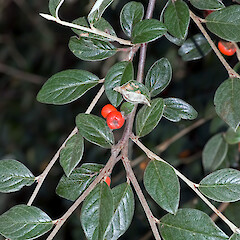Cotoneaster franchetii
Common name
cotoneaster, Franchet’s cotoneaster
Family
Rosaceae
Flora category
Vascular – Exotic
Structural class
Trees & Shrubs - Dicotyledons
Conservation status
Not applicable
Brief description
Widely branched shrub with arching branchlets, foliage conspicuously grey from a distance (young leaves densely hairy on both surfaces and remaining white-felted below when mature). Flowers with pink erect petals. Fruit orange with 3-5 pyrenes.
Habitat
Terrestrial. Outcompetes native shrub species in a wide variety of habitats. Usually dry forest and shrubland up to 300 m, forest margins, dry rangeland, bluffs, rocky sites, slips, riverbeds.
Detailed description
Evergreen shrub up to c. 3 m high; stems spreading and often somewhat arching; young shoots pale buff-tomentose, later becoming dark reddish brown. Leaves up to 35 x 18 mm, more or less shining and finely pilose with impressed veins above, usually with white to grey woolly tomentum (rarely pale buff) below. Flowers in clusters of 7-15 scattered along branches, Petals erect and pink. Fruit ellipsoid, oblong-obovoid, obovoid, or subglobose, 5-9 mm long, scarlet or orange scarlet.
Manaaki Whenua Online Interactive Key
Similar taxa
Has been confused with C. pannosus, but that species has flowers with spreading petals and almost always has 2 pyrenes (‘seeds’) per fruit, whereas C. franchetii has flowers with erect petals and mostly has 3 (up to 5) pyrenes per fruit.
Flowering
November, December, January
Flower colours
Red/Pink
Life cycle
Perennial. Very long lived. Large numbers of viable seed are produced in each fruit. Fruit are readily dispersed by birds.
Year naturalised
1958
Origin
China
Reason for introduction
Ornamental
Tolerances
Very tolerant of damp and drought, hot and cold, salt, and a range of soils.
Etymology
cotoneaster: From cotoneus an old Latin name for the quince, and possibly aster, corruption of adinstar ‘resembling’, i.e. quince-like







